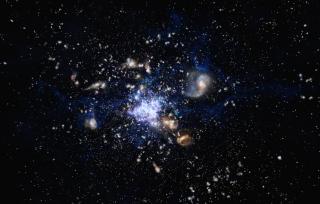Bibcode
De Breuck, C.; Lundgren, A.; Emonts, B.; Kolwa, S.; Dannerbauer, H.; Lehnert, M.
Bibliographical reference
Astronomy and Astrophysics
Advertised on:
2
2022
Journal
Citations
20
Refereed citations
18
Description
We present the detection of [CII] 158 μm emission from the Spiderweb galaxy at z = 2.1612 using the Atacama Pathfinder EXperiment (APEX). The line profile splits into an active galactic nucleus (AGN) and circumgalactic medium (CGM) component previously identified in CO and [CI]. We find that these individual [CII] components are consistent in terms of CO and far-IR luminosity ratios with the populations of other z ≳ 1 AGN and dusty star-forming galaxies. The CGM component dominates the [CII] emission in the 10″ APEX beam. Although we do not have spatially resolved data, the close correspondence of the velocity profile with the CO(1−0) detected only on scales of tens of kiloparsecs in CO(1−0) suggests that the [CII] emission is similarly extended, reminiscent of [CII] halos recently found around z > 5 galaxies. Comparing the first four ionization states of carbon, we find that the atomic [CI] emission is dominant, which increases its reliability as a molecular mass tracer. Our [CII] detection at 601.8 GHz also demonstrates the feasibility to extend the frequency range of ALMA Band 9 beyond the original specifications.
1D spectrum is also available at the CDS via anonymous ftp to cdsarc.u-strasbg.fr (ftp://130.79.128.5) or via http://cdsarc.u-strasbg.fr/viz-bin/cat/J/A+A/658/L2
Related projects

Molecular Gas and Dust in Galaxies Across Cosmic Time
Two of the most fundamental questions in astrophysics are the conversion of molecular gas into stars and how this physical process is a function of environments on all scales, ranging from planetary systems, stellar clusters, galaxies to galaxy clusters. The main goal of this internal project is to get insight into the formation and evolution of
Helmut
Dannerbauer